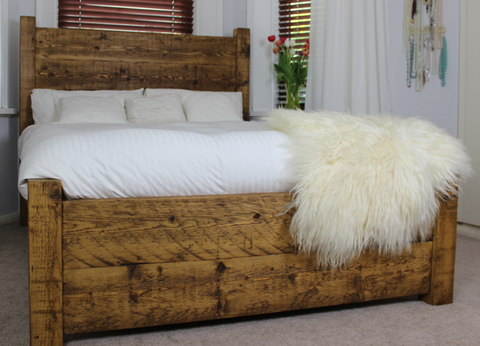Russell & Darrell, Designers & Master Craftsmen
Furniture making has been passed on through generations in the workshop, where fathers have passed on traditional skills to their sons. This timeless craftsmanship has proved to be a first-class skill, where attention to detail is imperative. The team at the workshop are all focused on creating individual made-to-measure wooden furniture for the home. The furniture is constructed using old reclaimed timber sourced from the UK.
The workshop can therefore be truly marked as British Made. Using locally-sourced, sustainable and reclaimed wood, in a British workshop, run by highly skilled craftsmen.
What made you carry on the family tradition of making furniture?
“Making furniture is second nature to me and the team. Our family have been doing this for generations. I couldn’t imagine doing anything else!” says Russell.
Both Darrell and Russell jointly lead the team and oversee everything before it goes out to customers. They both take a very hands on approach when it comes to making furniture. Quality is everything to them! When walking through the workshop, you can really sense the enthusiasm from their team, all enjoying and taking pride in their work.
Being one of the early adopters to start working with reclaimed wood, how easy is it to work with this material?
“Working with old wood has its challenges. We source only the highest grade wood we can find. A lot of our solid wooden furniture is thick and chunky. For example, a typical table top made for Modish Living is approx 7cm thick. Or the bed posts might be 10cm thick” says Darrell. “We therefore buy in lots of very solid reclaimed roof joists to make sure they can achieve this thickness”
The roof joists are removed from old building across the UK before they are demolished to make way for new developments.
There’s a lot of work that goes into preparing the reclaimed wood before it can be used. Often the large wooden beams that come into the workshop, will have large nails in them. The nails have to be removed before any work can start. This in itself can take a long time.
The nail holes then have to be treated and made good. However, they are still left visible, as they form part of the character of the finished item. “The nail holes look fantastic and make every piece of furniture unique and individual” says Russell.
What causes additional work for the team, is dealing with dents or large holes in the wood. Table tops are left with as much character as possible. However ,they do also need to be straight and flat, so glasses won’t tip over. The wood is therefore put through an initial sanding process to ensure the final end part can be used to size. To minimise waste, the team have to run a quality check on every piece of timber used, before any work is started.
“Once the materials are ready, we can pretty much get a table made in days” says Darrell. “The team are great working together. Between us, we’ll measure up. Cut the wood to size. And then start building”

What’s particularly nice about the workshop is everything is done by hand, unlike large factories where furniture is automated. Long steal rulers and pencils are used to draw up the cuts that need to be made, and bolts are secured by hand to fit perfectly.
Once the table is finished, it then gets moved on to the next section where it gets put through the final sanding process. The sanding process will vary from item to item. Depending on the wood, one piece of furniture might need a little more time than another. However the aim is to leave as much as they can of the original wood exposed, and with a beautiful finish.
After this has all taken place, the next stage of staining and waxing takes place. This is a process that’s worked on over time. And only once everything is complete, each item then gets quality checked before it’s packaged up.
What has been one of your biggest challenges in making furniture using reclaimed wood?
Each piece of furniture is made up by the team working closely together, so finding the right team member can be a challenge. There are lots of skilled craftsmen out there, however finding someone who understands reclaimed wood to the level that we do, can be hard. But we are lucky, as we now have a very loyal team that have been with us a long time.
Do you have any advise you could share with others who are possibly looking to start working with reclaimed wood?
“Reclaimed wood is not like new wood” says Russell. “We often use wood that’s over 150 years old. This wood is not cheap, so you really don’t want to waste it. I would say, plan what it is you want to make, take your time and find a way of working with the characters of the wood markings, making them a feature as opposed to removing them”